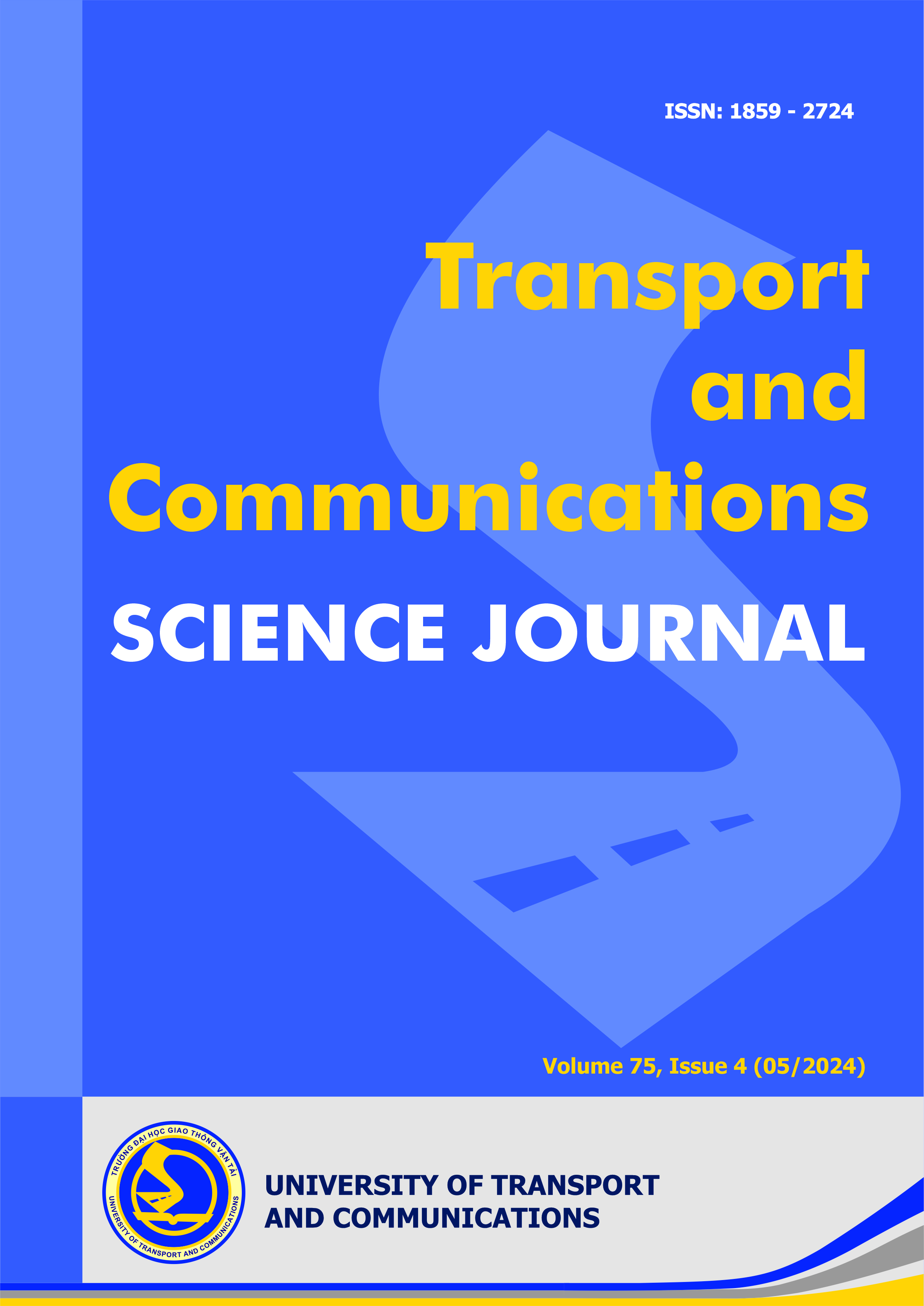Performance evaluation of bus stops on arterial roads in Hanoi city
Email:
tkduong@utc.edu.vn
Từ khóa:
Bus stop, Bus capacity, Public transport, Bus travel demand, Quality of service
Tóm tắt
The operations of critical bus stops on arterial roads substantially influence the facility bus capacity and the bus quality of service in terms of schedule reliability. The aim of this article is to employ the methodology in the Transit Capacity Quality of Service Manual (TCQSM) to better understand the performance of key bus stops on arterial roads in Hanoi city. The obtained results shown that the capacities of most examined bus stops (Bus Stops 02, 03, and 04) are considerably lower than the actual demands of buses on the considered roads, and increasing the number of loading areas at bus stops is one of the feasible solutions to effectively improve the capacity of bus stops in Hanoi city. The results achieved provide urban transport management agencies and public transport practitioners in Vietnam with a valuable tool for bus stop capacity measurement and additional information for bus quality of service improvementTài liệu tham khảo
[1]. Pham Dong, Huu Chanh, Public transport in Hanoi: setting high goals for poor infrastructure. https://laodong.vn/xa-hoi/van-tai-cong-cong-tai-ha-noi-ha-tang-yeu-van-dat-muc-tieu-cao-1090762.ldo, 2022, (accessed 10 October 2023).
[2]. P. Ryus, A. Danaher, M. Walker, F. Nichols, W. Carter, E. Ellis, L. Cherrington, A. Bruzzone, Transit Capacity and Quality of Service Manual, Washington, DC, 2013.
[3]. H. K. Sharma, B. Swami, Performance enhancement and congestion reduction at busy signalized at-grade intersection with Bus Rapid Transit corridor and mixed traffic in India, in Urban Public Transportation Systems, 2013 (2013) 136-147. https://doi.org/10.1061/9780784413210.013
[4]. J. Reilly, F. Aros-Vera, Estimating Capacity of High-Volume Bus Rapid Transit Stations. TRB 92nd Annual Meeting, 2013.
[5]. S. Jaiswal, J. Bunker, L. Ferreira, Influence of platform walking on BRT station bus dwell time estimation: Australian analysis. Journal of Transportation Engineering, 136 (2010) 1173-1179. https://doi.org/10.1061/(ASCE)TE.1943-5436.0000174
[6]. H. Yu, Q. Chen, Planning of BRT-Exclusive Lane and Analysis of Passenger Capacity, in ICTE 2013: Safety, Speediness, Intelligence, Low-Carbon, Innovation, (2013) 587-593. https://doi.org/10.1061/9780784413159.087
[7]. E. Babalık, E. C. Cengiz, Bus Rapid Transit System in Istanbul: A Success Story or Flawed Planning Decision?. Transport Review, 35 (2015) 792-813. https://doi.org/10.1080/01441647.2015.1059381
[8]. R. Widana Pathiranage, J. Bunker, A. Bhaskar. A microscopic simulation model to estimate bus rapid transit station bus capacity. in Australasian Transport Research Forum 2013 Proceedings. 2013.
[9]. R. Widanapathiranage, J. Bunker, A. Bhaskar, Modelling the BRT station capacity and queuing for all stopping busway operation, Public Transport, 7 (2015) 21-38. https://doi.org/10.1007/s12469-014-0095-y
[10]. A. L. Dodero, P. M. dos Santos da Rocha, J. J. Hernandez, A. Cerezo, Evaluating Improvements in Bus Rapid Transit in Mexico City, Mexico: How Feasible Is It to Improve a Consolidated System? Transportation Research Record, 2451 (2014) 88-96. https://doi.org/10.3141/2451-10
[11]. J. Bunker, High volume bus stop upstream average waiting time for working capacity and quality of service. Public Transport, 10 (2018) 311-333. https://doi.org/10.1007/s12469-018-0179-1
[12]. F. M. Hisham, J. M. Bunker, A. Bhaskar, Capacity Estimation of On-Street, Mid-Block, Off-Line Bus Stops Considering Yield-to-Bus Rule, Transportation Research Record, 2673 (2019) 269 - 278. https://doi.org/10.1177/0361198118822299
[13]. Manual, H.C., HCM2010. Washington, DC: Transportation Research Board, 2010.
[14]. TRB, H.C.M., A Guide for Multimodal Mobility Analysis, vol. Transportation Research Board, 2016.
[2]. P. Ryus, A. Danaher, M. Walker, F. Nichols, W. Carter, E. Ellis, L. Cherrington, A. Bruzzone, Transit Capacity and Quality of Service Manual, Washington, DC, 2013.
[3]. H. K. Sharma, B. Swami, Performance enhancement and congestion reduction at busy signalized at-grade intersection with Bus Rapid Transit corridor and mixed traffic in India, in Urban Public Transportation Systems, 2013 (2013) 136-147. https://doi.org/10.1061/9780784413210.013
[4]. J. Reilly, F. Aros-Vera, Estimating Capacity of High-Volume Bus Rapid Transit Stations. TRB 92nd Annual Meeting, 2013.
[5]. S. Jaiswal, J. Bunker, L. Ferreira, Influence of platform walking on BRT station bus dwell time estimation: Australian analysis. Journal of Transportation Engineering, 136 (2010) 1173-1179. https://doi.org/10.1061/(ASCE)TE.1943-5436.0000174
[6]. H. Yu, Q. Chen, Planning of BRT-Exclusive Lane and Analysis of Passenger Capacity, in ICTE 2013: Safety, Speediness, Intelligence, Low-Carbon, Innovation, (2013) 587-593. https://doi.org/10.1061/9780784413159.087
[7]. E. Babalık, E. C. Cengiz, Bus Rapid Transit System in Istanbul: A Success Story or Flawed Planning Decision?. Transport Review, 35 (2015) 792-813. https://doi.org/10.1080/01441647.2015.1059381
[8]. R. Widana Pathiranage, J. Bunker, A. Bhaskar. A microscopic simulation model to estimate bus rapid transit station bus capacity. in Australasian Transport Research Forum 2013 Proceedings. 2013.
[9]. R. Widanapathiranage, J. Bunker, A. Bhaskar, Modelling the BRT station capacity and queuing for all stopping busway operation, Public Transport, 7 (2015) 21-38. https://doi.org/10.1007/s12469-014-0095-y
[10]. A. L. Dodero, P. M. dos Santos da Rocha, J. J. Hernandez, A. Cerezo, Evaluating Improvements in Bus Rapid Transit in Mexico City, Mexico: How Feasible Is It to Improve a Consolidated System? Transportation Research Record, 2451 (2014) 88-96. https://doi.org/10.3141/2451-10
[11]. J. Bunker, High volume bus stop upstream average waiting time for working capacity and quality of service. Public Transport, 10 (2018) 311-333. https://doi.org/10.1007/s12469-018-0179-1
[12]. F. M. Hisham, J. M. Bunker, A. Bhaskar, Capacity Estimation of On-Street, Mid-Block, Off-Line Bus Stops Considering Yield-to-Bus Rule, Transportation Research Record, 2673 (2019) 269 - 278. https://doi.org/10.1177/0361198118822299
[13]. Manual, H.C., HCM2010. Washington, DC: Transportation Research Board, 2010.
[14]. TRB, H.C.M., A Guide for Multimodal Mobility Analysis, vol. Transportation Research Board, 2016.
Tải xuống
Chưa có dữ liệu thống kê

Nhận bài
23/11/2023
Nhận bài sửa
09/04/2024
Chấp nhận đăng
09/05/2024
Xuất bản
15/05/2024
Chuyên mục
Công trình khoa học
Kiểu trích dẫn
Tran Khac , D. (1715706000). Performance evaluation of bus stops on arterial roads in Hanoi city. Tạp Chí Khoa Học Giao Thông Vận Tải, 75(4), 1581-1592. https://doi.org/10.47869/tcsj.75.4.9
Số lần xem tóm tắt
196
Số lần xem bài báo
133









